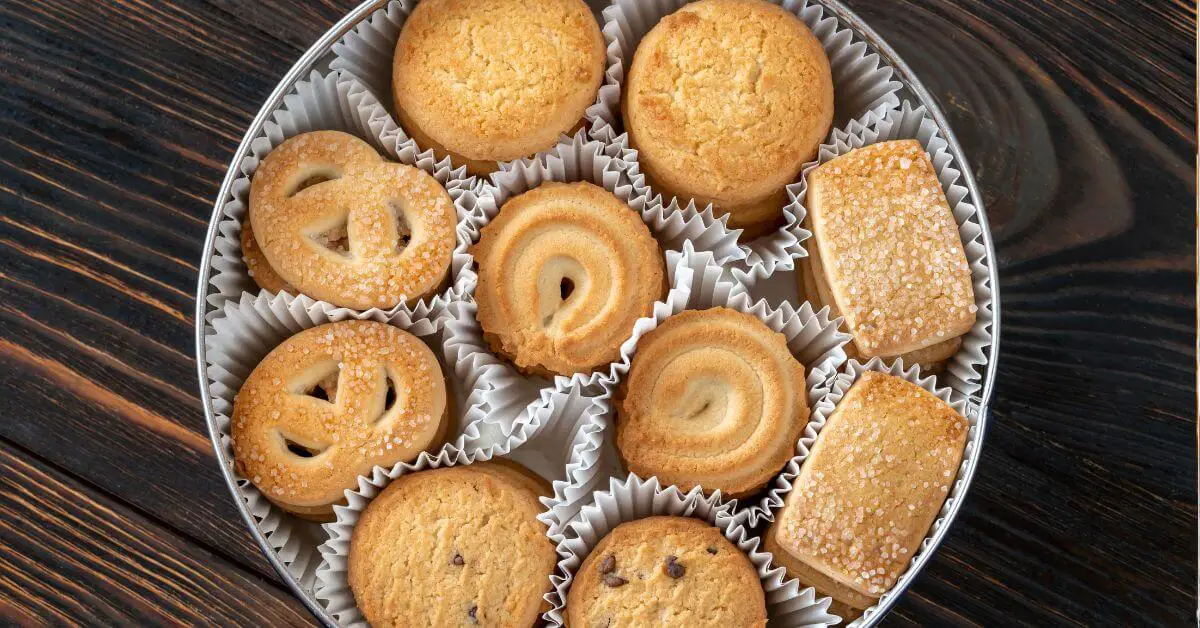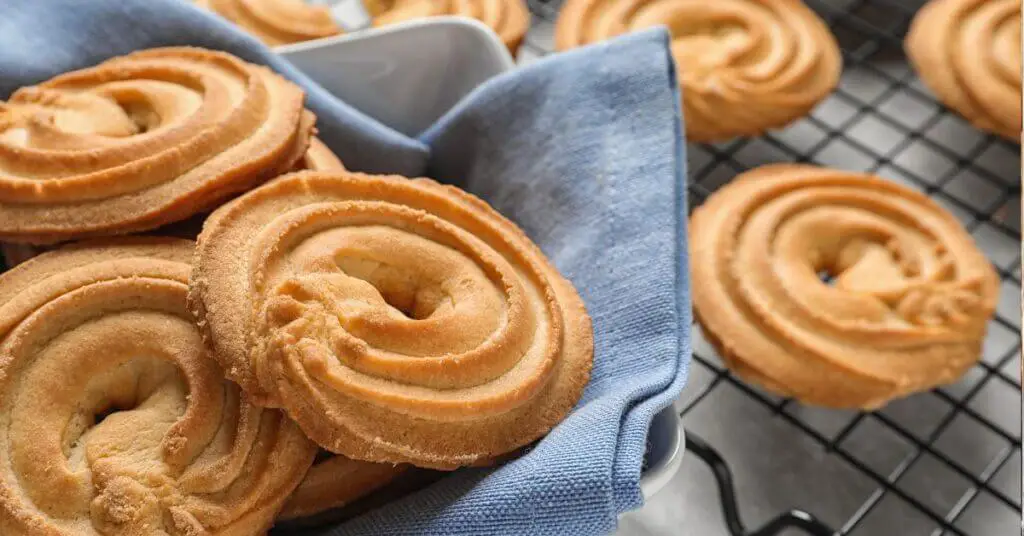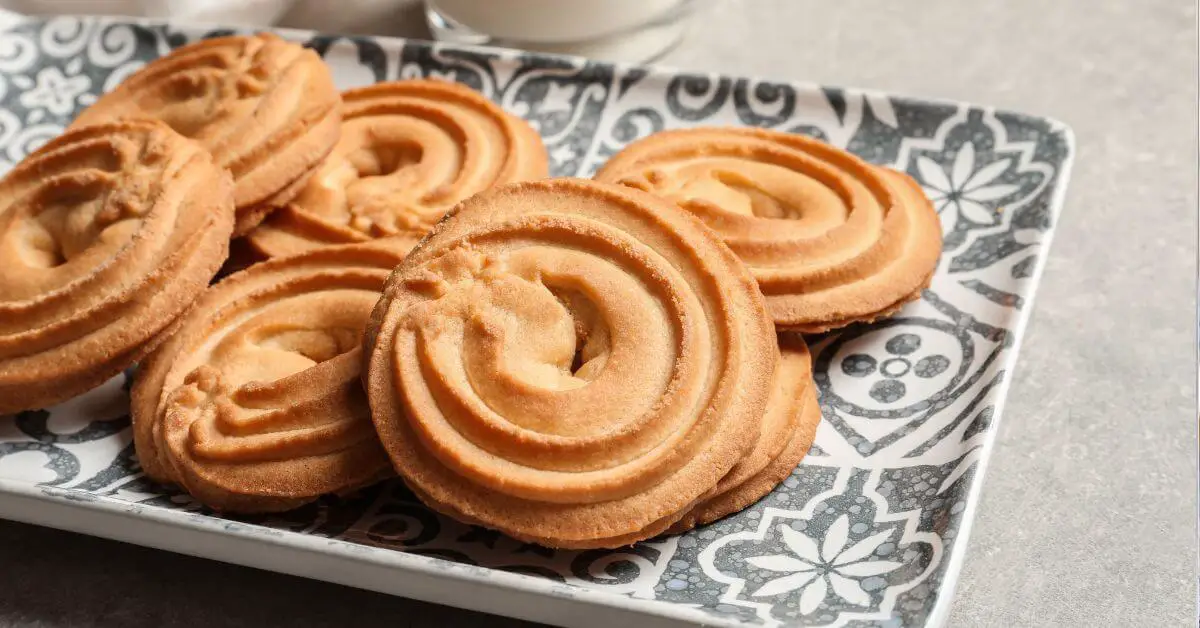Danish butter cookies, known for their rich flavor and delicate texture, have been a staple in Scandinavian baking for generations. Originating from Denmark, these cookies have gained immense popularity worldwide, becoming synonymous with quality and tradition. The key to their appeal lies in their simplicity and the use of high-quality ingredients, particularly the buttery flavor that stands out in every bite. These cookies are not just a treat; they’re a reflection of Danish culinary artistry and a cherished part of holiday cookies traditions around the globe.
The Art of Making Danish Butter Cookies
The allure of Danish butter cookies lies in their simplicity and the exceptional quality of their ingredients. These cookies, a staple in Danish baking, are renowned for their rich, buttery flavor and delicate texture, which are the results of traditional recipes and meticulous baking methods. Let’s delve into the artistry behind these beloved cookies.
Key Ingredients and Their Quality
- Butter: The heart of these cookies is high-quality butter, preferably with a high fat content. Danish bakers often use locally sourced butter, which imparts a rich, creamy flavor that is unmistakable.
- Flour: Fine-quality flour is essential for the perfect texture. It contributes to the cookies’ tender crumb and delicate structure.
- Sugar: Just the right amount of sugar not only sweetens the cookies but also affects their texture and color.
- Eggs: Eggs bind the ingredients together and contribute to the richness of the cookies.
The choice of ingredients is crucial. Each component must be of the highest quality to ensure the cookies have the right balance of flavor and texture.
Traditional Recipes and Methods
- Mixing: The ingredients are mixed carefully to avoid overworking the dough, which can affect the texture of the cookies.
- Shaping: Traditionally, the dough is piped into various shapes, each offering a different mouthfeel and aesthetic appeal.
- Baking: Precise baking is key. The cookies are baked just enough to achieve a light golden color, ensuring they are crisp yet tender.
These methods have been honed over generations, preserving the authenticity and distinctiveness of Danish butter cookies.
The Role of Butter in Flavor and Texture
- Flavor: The high butter content is responsible for the rich, luxurious taste that Danish butter cookies are famous for.
- Texture: Butter plays a pivotal role in achieving the melt-in-the-mouth texture. It helps in creating a delicate, crumbly consistency that sets these cookies apart from others.
In essence, the art of making Danish butter cookies is a blend of quality ingredients, time-honored recipes, and precise baking techniques. This combination results in a cookie that is not just a treat for the palate but also a representation of Danish culinary heritage. For more insights into the importance of butter in baking, you can explore Butter on Wikipedia.
Cultural Significance and Global Appeal
Danish butter cookies are more than just a sweet treat; they are a cultural icon. In Denmark, these cookies are a part of everyday life and special celebrations. Their global appeal can be attributed to several factors:
- Cultural Heritage: In Denmark, these cookies are a symbol of hospitality and are often served to guests.
- Global Reach: The iconic blue tins of Danish butter cookies have become a familiar sight in households around the world, especially during the holiday season.
- Universal Love: The simplicity and deliciousness of these cookies transcend cultural boundaries, making them beloved worldwide.
The cookies’ journey from a Danish specialty to a global phenomenon is a fascinating story of culinary migration. To understand more about this journey and the traditional Danish culinary history, a visit to History of Danish Cuisine on Wikipedia is recommended.
The Science Behind the Taste
The irresistible taste of Danish butter cookies is not just about the ingredients; it’s also about the science behind how these ingredients combine. The buttery flavor melds perfectly with the sugar and flour, creating a taste that’s rich yet not overpowering. Here’s a look at the science:
- Flavor Chemistry: The Maillard reaction during baking creates a complex array of flavors and aromas.
- Texture Science: The high butter content results in a tender crumb and a melt-in-the-mouth texture.
- Psychology of Taste: Our taste buds are wired to appreciate the balance of sweetness and rich buttery flavors in these cookies.
Understanding the science behind the taste adds another layer of appreciation for these cookies. For more on the psychology of taste in cookies, Wikipedia’s article on Taste provides valuable insights.
Comparative Analysis with Other Cookies
Danish butter cookies, a cherished treat from Denmark, hold a unique place in the world of baked goods. Their distinct characteristics set them apart from other popular cookies. This comparative analysis highlights what makes these cookies stand out and why they continue to be a global favorite.
Differences from Other Popular Cookies
Danish butter cookies distinguish themselves in the vast world of baked goods through their unique characteristics. These differences set them apart from other popular cookies, highlighting why they continue to be a global favorite.
Ingredient Simplicity
- Danish butter cookies stand out for their simple ingredient list. They typically consist of butter, sugar, flour, and sometimes vanilla, focusing on the quality of each component. This simplicity contrasts with many cookies that feature a range of ingredients like nuts, chocolate chips, or spices.
Texture
- The high butter content in Danish butter cookies gives them a delicate, crumbly texture. This texture differs significantly from the chewy feel of chocolate chip cookies or the crunchy snap of ginger snaps, offering a unique sensory experience.
Flavor Profile
- The rich, buttery taste is the hallmark of Danish butter cookies. This focus on the flavor of high-quality butter sets them apart from other cookies that might use a mix of flavors or less butter.
In summary, Danish butter cookies’ simplicity, unique texture, and rich buttery flavor make them distinct from other cookie varieties. Their adherence to traditional recipes and focus on high-quality ingredients contribute to their enduring appeal and cultural significance.
What Makes Danish Butter Cookies Unique
- Cultural Heritage: These cookies are not just a recipe; they’re a part of Danish heritage. Their history and the traditional methods used in their creation add a layer of cultural significance that many other cookies lack.
- Consistency in Quality: There’s a consistent quality to Danish butter cookies, largely due to the adherence to traditional recipes and the emphasis on high-quality ingredients. This consistency is a hallmark of their brand, recognized worldwide.
- Versatility in Occasions: While some cookies are associated with specific events or times of the year, Danish butter cookies transcend occasions. They are as suitable for a casual tea time as they are for festive celebrations.
In summary, Danish butter cookies distinguish themselves through their simplicity, quality, and heritage. Their unique texture, flavor profile, and cultural significance make them not just a culinary delight but also a symbol of Danish baking tradition. For those interested in exploring more about different baking traditions, Pinterest offers a wealth of information on Scandinavian Baking.
Packaging and Marketing Strategies

The packaging and marketing of Danish butter cookies have played a significant role in their global popularity. The iconic blue tin is instantly recognizable and has become synonymous with quality. Here’s a closer look:
- Iconic Packaging: The blue tin not only preserves the freshness of the cookies but has also become a collectible item in many households.
- Marketing Evolution: Over the years, the marketing strategies for these cookies have evolved, focusing on their heritage, quality, and the nostalgia associated with the blue tin.
The smart packaging and effective marketing have helped these cookies gain a special place in the hearts of consumers worldwide. For a deeper understanding of how packaging can impact food products, the Wikipedia page on Food Preservation is an excellent resource.
Health and Nutrition Aspects
While Danish butter cookies are a delightful indulgence, it’s important to consider their health and nutritional aspects. These cookies, like many treats, should be enjoyed in moderation as part of a balanced diet. Here’s an analysis of their nutritional content and some health considerations.
Nutritional Content Analysis
- Caloric Content: Danish butter cookies are high in calories, primarily due to their butter and sugar content. A typical serving can be calorie-dense, making portion control important.
- Fat Content: Butter, the key ingredient, contributes to the high saturated fat content in these cookies. While it’s responsible for their rich flavor and texture, it’s also something to be mindful of, especially for those monitoring fat intake.
- Sugar Content: These cookies are also high in sugar, which can contribute to increased blood sugar levels. This is a consideration for individuals with diabetes or those watching their sugar intake.
For those curious about healthier butter alternatives in baking, check out our guide on Country Crock Butter.
Health Considerations and Consumption Advice
- Moderation is Key: Enjoy Danish butter cookies as an occasional treat rather than a regular part of your diet. Balancing them with healthier food choices is crucial.
- Portion Control: Be mindful of portion sizes. Enjoying a few cookies rather than a whole tin can help manage calorie and sugar intake.
- Dietary Balance: If you indulge in these cookies, balance your diet with foods high in fiber, protein, and essential nutrients to offset the indulgence.
- Special Dietary Needs: For those with specific dietary restrictions, look for adapted recipes that cater to low-sugar, gluten-free, or low-fat diets.
For those interested in the nutritional aspects of foods and how they fit into a balanced diet, the Wikipedia page on Food and Nutrition offers comprehensive information.
Innovations and Variations
Danish butter cookies, while deeply rooted in tradition, have not remained untouched by modern culinary trends and global influences. Bakers and confectioners have creatively infused new life into these classic cookies, introducing innovative twists and variations that cater to contemporary tastes and global palates.
Modern Twists and Variations
Danish butter cookies have evolved beyond their traditional roots, embracing modern culinary trends and global flavors. Bakers and confectioners actively infuse new life into these classic cookies, introducing innovative twists and variations that cater to contemporary tastes and global palates.
Flavor Infusions
- Bakers are reinventing classic Danish butter cookies by adding new flavors such as lemon zest, almond extract, or cinnamon. These additions refresh the traditional recipe with exciting new tastes.
Texture Innovations
- Some variations include finely chopped nuts or a layer of jam, introducing new textures to the cookies. These additions enhance the sensory experience of the cookies, making them more appealing to a broader audience.
Dietary Adaptations
- Responding to health-conscious consumers, bakers are creating versions of Danish butter cookies with alternative sweeteners, gluten-free flour, or reduced-fat content. These adaptations make the cookies accessible to those with specific dietary preferences or restrictions.
These modern adaptations and innovations showcase the versatility of Danish butter cookies and their potential as a canvas for creative baking. The ability to adapt and blend with various culinary traditions highlights the cookie’s universal appeal and enduring popularity.
Fusion with Other Culinary Traditions
- Cross-Cultural Blends: Danish butter cookies have been creatively combined with elements from other culinary traditions. For instance, matcha powder for a Japanese twist, or incorporating spices like cardamom for an Indian-inspired flavor.
- Hybrid Creations: Some bakers have experimented with hybrid forms, such as combining the dough of Danish butter cookies with other popular cookie types, creating unique, fusion cookies.
- Savory Versions: Moving beyond the sweet realm, there are savory versions of these cookies, incorporating ingredients like cheese or herbs, perfect for pairing with wines or as appetizers.
These innovations and fusions not only keep the Danish butter cookie relevant in today’s diverse culinary landscape but also showcase the cookie’s potential as a canvas for creative baking. The ability to adapt and blend with various culinary traditions speaks to the cookie’s universal appeal and enduring popularity. For creative baking ideas and inspiration, Pinterest’s collection on Cookie Decoration is a treasure trove.
Consumer Perspectives and Reviews
Consumer perspectives and reviews shed light on why Danish butter cookies remain a global favorite. Customers often praise:
- Consistent Quality: The cookies are known for their consistent high quality.
- Nostalgic Appeal: Many consumers associate them with fond memories, enhancing their appeal.
- Versatility: These cookies are suitable for various occasions, from casual snacking to formal gatherings.
Understanding consumer trends is crucial for any product’s success. For more on consumer behavior and marketing, the Wikipedia article on Food Marketing provides valuable insights.
FAQs
- What are Danish Butter Cookies?
- Danish butter cookies are biscuits or cookies made traditionally with butter, flour, sugar, and often vanilla or almond flavoring. They stand out for their rich buttery flavor and delicate, crumbly texture. The iconic Royal Dansk blue tin commonly represents these cookies.
- What makes Danish Butter Cookies different from other cookies?
- Their simplicity and the high quality of ingredients, especially the butter, set Danish butter cookies apart. They boast a unique rich, buttery flavor and a delicate texture that melts in your mouth, distinguishing them from other cookie varieties.
- How are Danish Butter Cookies made?
- To make Danish butter cookies, bakers cream butter and sugar together, then add flour (and sometimes egg yolks) to create a dough. They pipe this dough into various shapes and bake it until lightly golden. The high butter content is essential for their characteristic flavor and texture.
- Can you make Danish Butter Cookies at home?
- Absolutely, you can make Danish butter cookies at home. Numerous online recipes replicate the classic taste of these cookies, typically requiring basic ingredients like butter, sugar, flour, and sometimes egg yolks or flavorings like vanilla.
- Are there variations of Danish Butter Cookies?
- Indeed, there are variations that incorporate flavors like lemon, chocolate, or almond. Some modern recipes also modify the cookies to suit dietary needs, offering gluten-free or reduced-sugar versions.
Expand your dessert repertoire with our guide on Mastering the Art of Homemade Ice Cream Bars.
Conclusion and Future Outlook
Danish butter cookies have stood the test of time, evolving while maintaining their core qualities. The future looks bright as they continue to adapt to changing consumer preferences and global trends. We can expect to see more innovative flavors, healthier options, and even more creative marketing strategies. The enduring appeal of these cookies lies in their ability to blend tradition with modernity, ensuring they remain a beloved treat for generations to come.
For a broader perspective on how food trends evolve globally, the Wikipedia page on Globalization of Food offers an insightful read.

